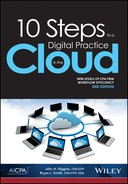Appendix B: Glossary
back-office processes. Supporting business functions, such as accounting, finance, payroll, employee benefits, and IT that provide infrastructure for an organization’s vision and create a platform for growth. Back-office processes are also referred to as noncore processes.
business process outsourcing. A process of delegating the back-office processes or noncore business functions to a third party service provider.
client accounting services. Services offered by CPA firms to their clients to help them manage their finance and accounting functions. Although the services offered within a client accounting services practice vary, they generally fall into three categories: (1) after-the-fact financial statement preparation, (2) transaction processing, and (3) CFO/controller services.
client assessment. A thorough review of a client’s current operating environment to gain insight into his or her current business operations. This includes reviewing and documenting operational workflow and business practices, understanding and documenting business structure, and control activity information. This information enables the CPA firm to understand areas of the client’s operation that can be improved and how your firm’s services and systems can address those areas for improvement.
client service delivery model. This describes the methodology a CPA firm uses to share software and data when performing client accounting services. There are generally three service delivery models:
(1) Where the software resides at the client’s location and at the firm’s location; the software may or may not be the same. The firm and client exchange data files. Soft copies of the file may be exchanged in various ways.
(2) Where the software and data resides on third party software as a service (SaaS) cloud-based (or Web-based) servers. Both the client and firm share this common cloud-based business platform. Client and firm access the software and data via an Internet browser.
(3) A combination of the both options.
cloud-based computing. The term cloud is used as a metaphor for the Internet. Typical cloud computing service providers deliver common business applications and software online, which are accessed from a Web browser, while the software and data are stored on third party servers. Clients can typically purchase access as needed and can increase or reduce services as their needs change. The cloud computing service delivery vendor develops and supports the solution and runs all operations.
core business processes. These are the business processes that move an organization’s vision forward, such as sales, marketing, business development, and customer service. Core business processes are also referred to as front-office processes.
field examination and discovery. A part of the client assessment process that involves being on-site at the client’s operations, meeting with business process owners, and studying the current operations and workflow.
finance and accounting outsourcing (FAO). A specific type of outsourcing known as FAO for finance and accounting outsourcing or the outsourcing of an organization’s finance and accounting (F&A) functions. This is a term used by companies to describe the outsourcing of their F&A function. It is also used by accounting firms to describe services they provide.
front-office processes. These are the business functions that move an organization’s vision forward, such as sales, marketing, business development, and customer service. Front-office processes are also referred to as core business processes.
hosting. This is a software deployment in which the customer acquires the software, and a service provider delivers IT infrastructure and “hosts” by creating a single operating environment (virtual or physical) to allow a single customer to access and utilize dedicated computing resources for a software vendor’s product.
A few points to consider:
These applications are traditional, single-tenant applications but hosted by a third party. They are client-server applications with HTML front ends added to allow remote access to the application.
The applications are not written as net-native applications. As a result, the performance and application updates may be no better than self-managed premise-based applications.
By comparison, cloud-based SaaS applications are multitenant applications hosted by a vendor that have been designed as net-native applications that automatically get updated on an ongoing basis.
on-demand service. Services delivered in which a client can purchase access to software delivered via the Internet. Clients can purchase access as needed and can increase or reduce services as their needs change. Also known as software as a service.
scalability. The measure of a service’s ability to increase or decrease in performance and cost in response to changes in needs or volume. It is important that a service be scalable if an organization anticipates growth and increased needs.
service delivery platform. The software solutions and technology components that will be used in a firm’s client accounting service delivery.
service level agreement (SLA). A contractual agreement in which a service provider defines the level of service, responsibilities, priorities, and guarantees regarding timing, availability, performance, and other aspects of the service.
service level requirements (SLR). A document in which the business requirements for outsourced services are recorded. The SLR provides a basis for negotiations linked to the formulation of SLAs.
service organization or provider. Within the context of cloud computing, the service organization or provider is the business that delivers a cloud computing application as a service for a monthly fee.
software as a service (SaaS). Cloud application services in which applications are delivered over the Internet by the software provider, typically for a monthly fixed fee. The applications are not installed, nor do they run on the client’s computers; instead, they are accessed by a Web browser. Two important characteristics of SaaS are as follows:
Network and Web-based access to commercial software computing services in which the processing is done on a third party server, rather than at each customer’s location.
A tenant-based pricing model for hardware, software, administration, and consulting services.
